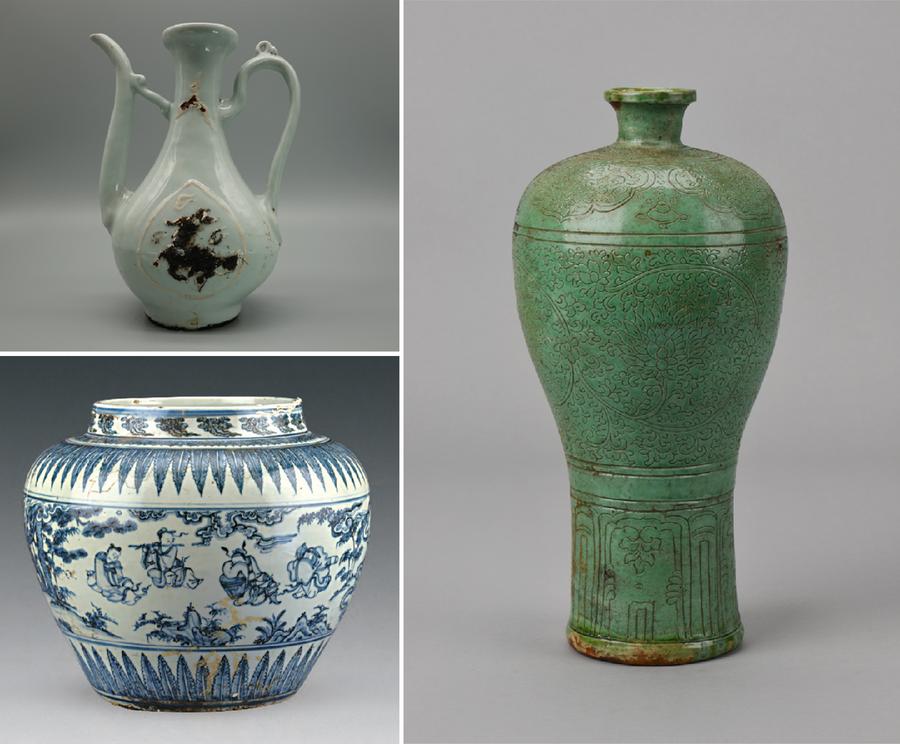
This undated combo photo shows pieces of cultural relics retrieved from two ancient shipwrecks discovered in the South China Sea. (NCHA/Handout via Xinhua)
HAIKOU, June 14 (Xinhua) -- About 150 kilometers southeast of Sanya City in China's southern island province of Hainan, at a depth of about 1,500 meters beneath the deep blue sea, lie two shipwrecks revealing the bustling trade activities along the ancient Maritime Silk Road.
Through joint excavation efforts involving research institutes and a local museum over the past two years, more than 900 pieces of cultural relics have been retrieved from the shipwrecks.
A total of 890 pieces of relics were excavated from the No. 1 shipwreck, including porcelain and pottery items, as well as copper coins. From the No. 2 shipwreck, 38 ancient artifacts were retrieved, including lumber, porcelain and pottery products, turban shells, and deer antlers, the National Cultural Heritage Administration (NCHA) told a press briefing on Thursday.
Discovered in October 2022 near the northwest continental slope of the South China Sea, the two well-preserved shipwrecks date back to the Ming Dynasty (1368-1644). The discovery is not only major deep-sea archaeological discoveries in China but also significant archaeological findings on a global scale.
"They were both considered to be privately owned commercial ships as the No. 1 shipwreck was loaded with pottery and porcelain objects to be sold overseas and the No. 2 shipwreck carried timber imported from abroad," said Song Jianzhong, a staffer of the National Center for Archaeology of the NCHA.
According to Song, the No. 1 ship may have departed from ports in the provinces of Guangdong or Fujian and was heading for the trade hub Malacca in Malaysia, while the No. 2 ship may have picked up logs at Malacca and was on its way back to Guangdong or Fujian.
The exquisite artifacts vividly depict the bustling trade activities during the mid-Ming Dynasty, Song said, adding that they serve as crucial evidence of the ancient Maritime Silk Road trade, providing important physical materials for research on Chinese maritime history, ocean trade history and cultural exchanges between China and foreign countries.
The excavation was made possible by China's advanced deep-sea technologies and equipment for archaeological surveys. Experts used 3D laser scanners, high-definition cameras, and submersible mud-pumping and blowing devices for this archaeological excavation.
"This deep-sea archaeological investigation, integrating China's deep-sea science and technology and underwater archaeology, marks the country's achievement of a world-class level in deep-sea archaeology," said Guan Qiang, deputy head of the NCHA.
The archaeological investigation involving the two shipwrecks has secured significant progress, but the exploration of underwater legends is far from over.
Wang Zhongyun, deputy director of the Hainan Provincial Department of Tourism, Culture, Radio, Television and Sports, pledged efforts to promptly organize the materials of the findings, launch special exhibitions and publish picture catalogs of the retrieved artifacts.
Wang added that the survey of underwater cultural heritage in the South China Sea will continue, with the objective of deepening understanding and laying the groundwork for the protection and sustainable development of underwater cultural heritage in the region.




 A single purchase
A single purchase









